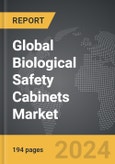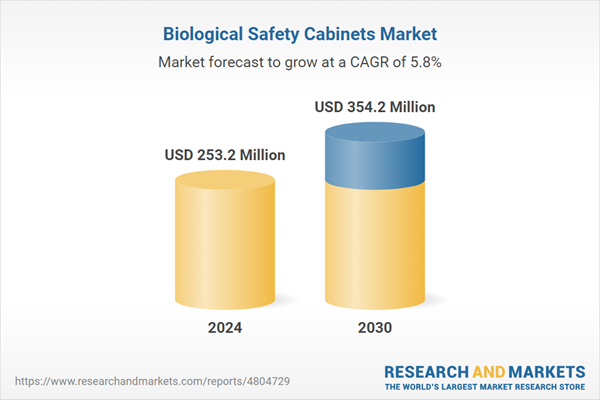The global market for Biological Safety Cabinets was valued at US$253.2 Million in 2024 and is projected to reach US$354.2 Million by 2030, growing at a CAGR of 5.8% from 2024 to 2030. This comprehensive report provides an in-depth analysis of market trends, drivers, and forecasts, helping you make informed business decisions. The report includes the most recent global tariff developments and how they impact the Biological Safety Cabinets market.
Segments: Type (Class I, Class II, Class III); End-Use (Pharma & Biopharma Companies, Diagnostic & Testing Laboratories, Academic & Research Institution).
Geographic Regions/Countries: World; United States; Canada; Japan; China; Europe (France; Germany; Italy; United Kingdom; and Rest of Europe); Asia-Pacific; Rest of World.
The analysts continuously track trade developments worldwide, drawing insights from leading global economists and over 200 industry and policy institutions, including think tanks, trade organizations, and national economic advisory bodies. This intelligence is integrated into forecasting models to provide timely, data-driven analysis of emerging risks and opportunities.
Global Biological Safety Cabinets Market - Key Trends and Drivers Summarized
What Makes Biological Safety Cabinets Crucial in Modern Laboratories?
Biological Safety Cabinets (BSCs) are indispensable tools in laboratories where work with potentially hazardous biological agents occurs. These specialized, enclosed workspaces are designed to protect the user, the environment, and the research material from exposure to harmful contaminants. The design of a BSC includes a high-efficiency particulate air (HEPA) filter system, which traps infectious agents like bacteria and viruses, preventing them from escaping into the surrounding environment. BSCs are categorized into three classes: Class I, II, and III, each providing varying levels of protection and containment. Class I cabinets offer basic protection, shielding the user and environment but not the sample. In contrast, Class II and III cabinets offer higher protection levels, with Class III providing the maximum containment. These differences make BSCs versatile for various applications, from academic research to pharmaceutical development, where stringent biosafety protocols are essential. The importance of these cabinets cannot be overstated in a world where the safe handling of biological materials is paramount.How Are Regulations Shaping The Evolution of Biological Safety Cabinets?
Regulatory standards are pivotal in shaping the design and implementation of Biological Safety Cabinets. International bodies like the World Health Organization (WHO), Centers for Disease Control and Prevention (CDC), and the Occupational Safety and Health Administration (OSHA) have established rigorous guidelines to ensure the safety and efficacy of these cabinets. These standards dictate everything from airflow patterns to filter integrity, ensuring that BSCs maintain their protective function under various operational conditions. Compliance with these regulations is not just a matter of legal necessity but a critical component of maintaining workplace safety and public health. Additionally, technological advancements driven by these regulations have led to the development of more sophisticated BSCs, featuring improved airflow dynamics, energy-efficient systems, and enhanced ergonomic designs to reduce user fatigue. As laboratories worldwide adhere to increasingly stringent biosafety requirements, the role of regulatory frameworks in driving innovation and adoption of BSCs becomes increasingly apparent.What Innovations Are Driving The Adoption of Advanced Biological Safety Cabinets?
The landscape of Biological Safety Cabinets has been transformed by innovations that enhance their functionality, efficiency, and user-friendliness. Recent developments include advanced airflow control systems, which not only improve containment but also reduce energy consumption, addressing one of the long-standing challenges of operating BSCs. Digital monitoring systems are another significant innovation, allowing real-time tracking of cabinet performance and immediate detection of any faults or breaches in safety. These systems often integrate with laboratory management software, streamlining operations and ensuring compliance with safety protocols. Furthermore, the shift towards sustainable laboratory practices has led to the design of BSCs that utilize eco-friendly materials and offer lower energy footprints. Ergonomic improvements, such as adjustable stands and quieter operation, have also become a focus, enhancing user comfort and reducing the physical strain of working long hours in a BSC. These innovations have not only made BSCs more effective but have also broadened their appeal across various sectors, from academic research to industrial applications.What Are the Factors Fueling Growth in the Biological Safety Cabinet Market?
The growth in the Biological Safety Cabinet market is driven by several factors that reflect both technological advancements and evolving industry demands. One of the primary drivers is the increasing emphasis on biosafety in research and healthcare settings, spurred by rising concerns about emerging infectious diseases and bioterrorism threats. This has led to higher demand for BSCs across a variety of sectors, including pharmaceuticals, biotechnology, and academic research. Additionally, the rapid expansion of the pharmaceutical and biotechnology industries, particularly in developing regions, is creating new opportunities for BSC manufacturers. The trend towards personalized medicine, which requires handling highly specific and often hazardous biological materials, is also contributing to market growth. Technological innovations that improve the efficiency, safety, and environmental impact of BSCs are further propelling their adoption. Moreover, stringent regulatory requirements worldwide are pushing laboratories to upgrade or replace outdated equipment, thereby fueling market demand. As a result, the Biological Safety Cabinet market is experiencing robust growth, driven by a confluence of factors that underscore the critical importance of these devices in ensuring laboratory safety and efficacy.Report Scope
The report analyzes the Biological Safety Cabinets market, presented in terms of units. The analysis covers the key segments and geographic regions outlined below.Segments: Type (Class I, Class II, Class III); End-Use (Pharma & Biopharma Companies, Diagnostic & Testing Laboratories, Academic & Research Institution).
Geographic Regions/Countries: World; United States; Canada; Japan; China; Europe (France; Germany; Italy; United Kingdom; and Rest of Europe); Asia-Pacific; Rest of World.
Key Insights:
- Market Growth: Understand the significant growth trajectory of the Class I Safety Cabinets segment, which is expected to reach US$121.7 Million by 2030 with a CAGR of a 5.6%. The Class II Safety Cabinets segment is also set to grow at 6.2% CAGR over the analysis period.
- Regional Analysis: Gain insights into the U.S. market, valued at $68.2 Million in 2024, and China, forecasted to grow at an impressive 5.5% CAGR to reach $55.8 Million by 2030. Discover growth trends in other key regions, including Japan, Canada, Germany, and the Asia-Pacific.
Why You Should Buy This Report:
- Detailed Market Analysis: Access a thorough analysis of the Global Biological Safety Cabinets Market, covering all major geographic regions and market segments.
- Competitive Insights: Get an overview of the competitive landscape, including the market presence of major players across different geographies.
- Future Trends and Drivers: Understand the key trends and drivers shaping the future of the Global Biological Safety Cabinets Market.
- Actionable Insights: Benefit from actionable insights that can help you identify new revenue opportunities and make strategic business decisions.
Key Questions Answered:
- How is the Global Biological Safety Cabinets Market expected to evolve by 2030?
- What are the main drivers and restraints affecting the market?
- Which market segments will grow the most over the forecast period?
- How will market shares for different regions and segments change by 2030?
- Who are the leading players in the market, and what are their prospects?
Report Features:
- Comprehensive Market Data: Independent analysis of annual sales and market forecasts in US$ Million from 2024 to 2030.
- In-Depth Regional Analysis: Detailed insights into key markets, including the U.S., China, Japan, Canada, Europe, Asia-Pacific, Latin America, Middle East, and Africa.
- Company Profiles: Coverage of players such as Air Science LLC, Berner International, BIOBASE, Cruma - Diantech Solutions S.L., Esco Micro Pte. Ltd. and more.
- Complimentary Updates: Receive free report updates for one year to keep you informed of the latest market developments.
Some of the 42 companies featured in this Biological Safety Cabinets market report include:
- Air Science LLC
- Berner International
- BIOBASE
- Cruma - Diantech Solutions S.L.
- Esco Micro Pte. Ltd.
- Euroclone S.p.A.
- Germfree
- Kewaunee Scientific Corporation
- Labconco Corporaton
- NuAire, Inc.
- The Baker Company, Inc.
- Thermo Fisher Scientific, Inc.
Tariff Impact Analysis: Key Insights for 2025
Global tariff negotiations across 180+ countries are reshaping supply chains, costs, and competitiveness. This report reflects the latest developments as of April 2025 and incorporates forward-looking insights into the market outlook.The analysts continuously track trade developments worldwide, drawing insights from leading global economists and over 200 industry and policy institutions, including think tanks, trade organizations, and national economic advisory bodies. This intelligence is integrated into forecasting models to provide timely, data-driven analysis of emerging risks and opportunities.
What’s Included in This Edition:
- Tariff-adjusted market forecasts by region and segment
- Analysis of cost and supply chain implications by sourcing and trade exposure
- Strategic insights into geographic shifts
Buyers receive a free July 2025 update with:
- Finalized tariff impacts and new trade agreement effects
- Updated projections reflecting global sourcing and cost shifts
- Expanded country-specific coverage across the industry
Table of Contents
I. METHODOLOGYII. EXECUTIVE SUMMARY2. FOCUS ON SELECT PLAYERSIII. MARKET ANALYSISIV. COMPETITION
1. MARKET OVERVIEW
3. MARKET TRENDS & DRIVERS
4. GLOBAL MARKET PERSPECTIVE
UNITED STATES
CANADA
JAPAN
CHINA
EUROPE
FRANCE
GERMANY
ITALY
UNITED KINGDOM
REST OF EUROPE
ASIA-PACIFIC
REST OF WORLD
Companies Mentioned (Partial List)
A selection of companies mentioned in this report includes, but is not limited to:
- Air Science LLC
- Berner International
- BIOBASE
- Cruma - Diantech Solutions S.L.
- Esco Micro Pte. Ltd.
- Euroclone S.p.A.
- Germfree
- Kewaunee Scientific Corporation
- Labconco Corporaton
- NuAire, Inc.
- The Baker Company, Inc.
- Thermo Fisher Scientific, Inc.
Table Information
| Report Attribute | Details |
|---|---|
| No. of Pages | 194 |
| Published | April 2025 |
| Forecast Period | 2024 - 2030 |
| Estimated Market Value ( USD | $ 253.2 Million |
| Forecasted Market Value ( USD | $ 354.2 Million |
| Compound Annual Growth Rate | 5.8% |
| Regions Covered | Global |









